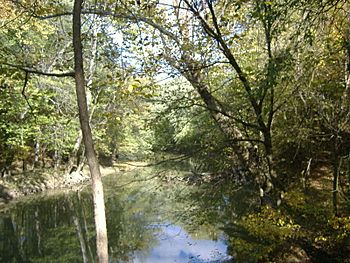Silver Creek (Ohio River tributary) facts for kids
Quick facts for kids Silver Creek |
|
|---|---|

Silver Creek, by Lapping Park
|
|
| Country | US |
| Physical characteristics | |
| River mouth | Ohio River |
| Length | 38 miles (61 km) |
| Basin features | |
| Basin size | 97,442 acres (394.33 km2) |
Silver Creek is a stream located in southern Indiana, United States. It's like a natural drain for a large area, collecting water from about 97,442 acres (394.33 km2) of land. The creek begins its journey in Scott County and flows for about 38.0 miles (61.2 km). Along its path, it drops about 168 feet (51 m) in elevation before finally joining the mighty Ohio River.
Contents
About Silver Creek
Silver Creek forms a natural border between Clark County and Floyd County. It's an important waterway that has been part of Indiana's history for a long time.
Why is it Called Silver Creek?
The name "Silver Creek" has a fun story behind it! When the land around the creek was given to a famous explorer named George Rogers Clark, people already called it Silver Creek. George Rogers Clark even lived in a simple log cabin near where the creek meets the Ohio River. The creek got its name because of a rumor that silver treasure was hidden nearby, or that silver ore could be found in the area. Imagine if that were true!
Early Industry by the Creek
Silver Creek was also important for early businesses. The very first place in Indiana to make cement was located right at the mouth of Silver Creek. This happened at a place called Beach's Mill in 1830. Cement was a very important material for building homes and other structures back then, just like it is today.
A Historic Meeting Spot
Long ago, Silver Creek was known for a spot called Shirt-Tail Bend. This was a popular place for people from Kentucky to settle disagreements in a special way called a "duel." Dueling was against the law in Kentucky, so people would cross the river into Indiana to do it.
At least four duels took place on the banks of Silver Creek. One of the most famous happened on January 19, 1809, between two important politicians: Humphrey Marshall and Henry Clay. Both men received only minor injuries. Their disagreement was about whether Kentucky lawmakers should wear clothes made in America or fancy cloth from England.

